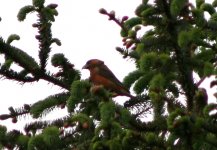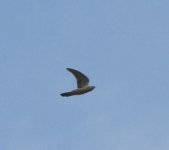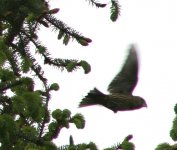________________________________________________________________Whilst stoat is the commonest mustelid running around during the day. There is a possibility it was one of several others. Pine martins are restricted to woodlands pretty much. This is the picture supplied above. They are quite difficult to see (only ever seen one myself).
Stoat is quite common. Same general shape as above, about the size of a large rat. A lighter golden coat with a creamy white chest and belly. Black tip to the thin upright tail.
Mink is an introduced species and is highly variable in colour due to the high level of breeding for the fur industry. The majority of mink are dark coated and would easly fit your description of being small cat sized and small headed.
The can range in colour from white to grey to tan and to dark chocolate or black.
Polecat, another introduced species is also a possibility. Though not as common as mink, they do occasionally escape. Similar size to mink, the nominate colour is brown and grey body with a racoon like face.
Ferrets are a smaller version of these and again an escapee species (tho not usually recorded, they are a reasonably common pet species).
Id put my money on a mink.
Owen
I was driving near the large protected woods in Newry and only lots of fields with no houses between the woods and where I saw it. We used to see rats and very large ones at that at the Luby or old dump long ago at the Ferry woods in Omeath and it was definitely much, much bigger than rats. More the size of a big full sized cat (not small) but definitely thinner and longer than a cat. I have very little knowlege of small animals like that and never even heard of Pine Martins in my life until read recently about them. I would think whatever it is it came from the large protected woodland nearby. Just rushing back to work now.






